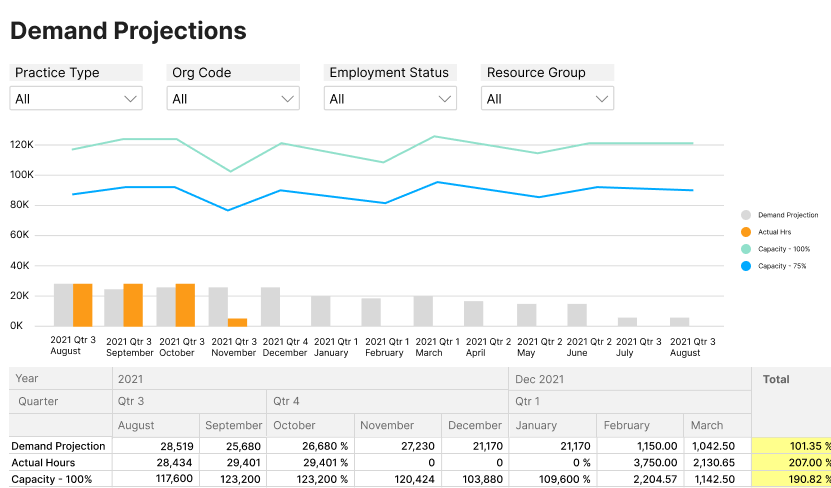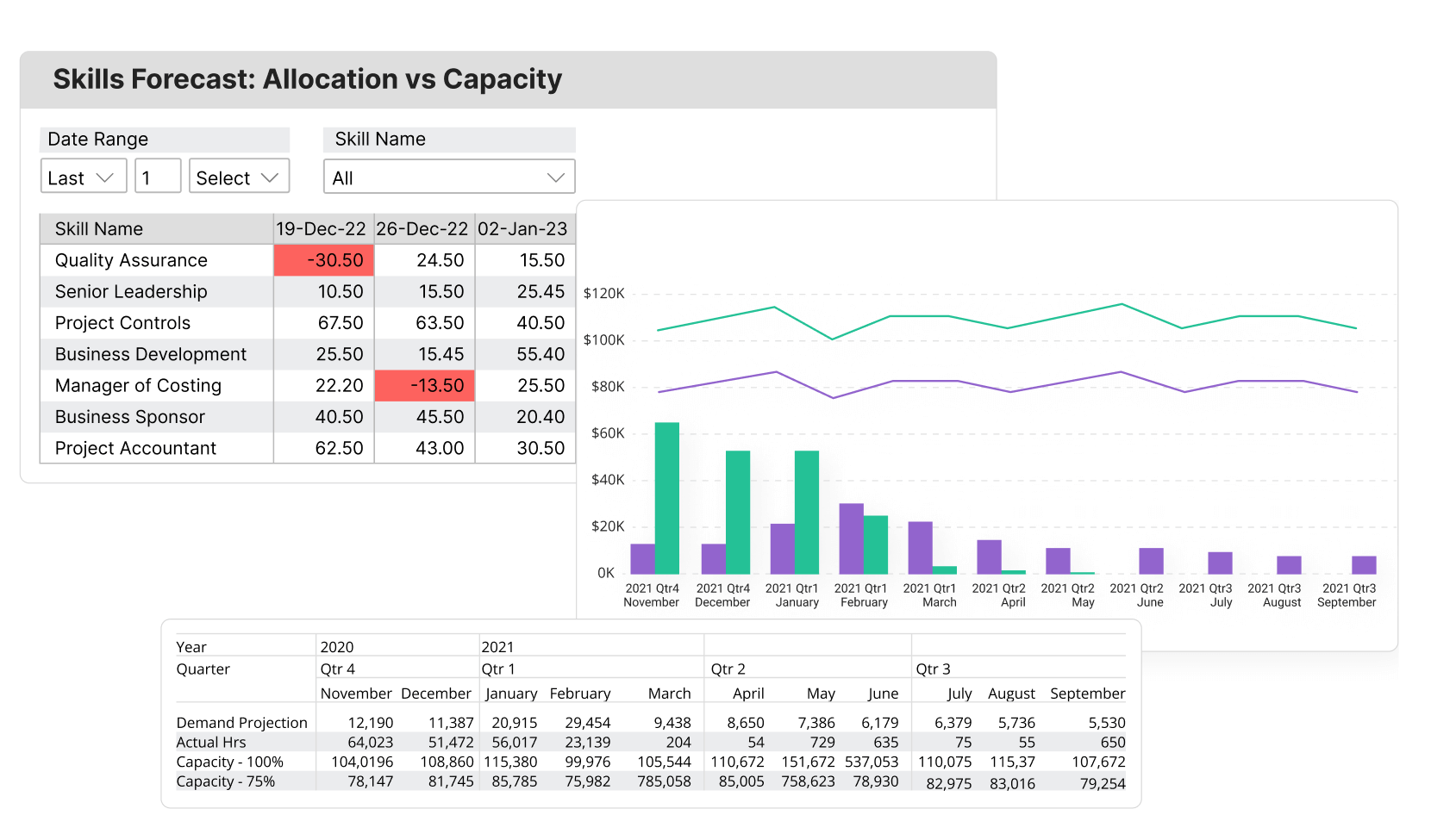What is resource forecasting?
Resource forecasting is the process of estimating future resource requirements based on historical data, current trends, and future demand. In business, resource forecasting is crucial for predicting future staffing needs, managing budgets, and ensuring that resources are utilized efficiently.
Why is resource forecasting important?
Resource forecasting is important for several reasons.
- It helps organizations plan for the future by ensuring they have enough resources to meet future demands. This can be especially important for businesses that have fluctuating demand, as it can be difficult to manage resources without accurate forecasting
- Resource forecasting helps organizations optimize resource utilization. By accurately predicting future resource needs, organizations can avoid underutilization or overutilization of resources, which can lead to wasted time, money, and effort.
- Resource forecasting is important for managing budgets. Accurate forecasting can help organizations allocate resources more effectively, ensuring that they are able to stay within budget constraints.

Challenges in resource forecasting
While resource forecasting offers numerous benefits, organizations often face certain challenges that can hinder the accuracy and effectiveness of their forecasts.
- Data Quality and Availability: Inaccurate or incomplete historical data can lead to unreliable forecasts. Ensuring data quality and having access to up-to-date information is essential for making accurate predictions.
- External Factors: Changes in market conditions, industry trends, or unforeseen events can disrupt resource demand. Incorporating external factors into forecasts can be challenging but is crucial for accurate predictions.
- Complexity of Projects: Resource forecasting becomes more complex with multi-dimensional projects that require diverse skill sets and resources. Balancing these complexities requires sophisticated modeling techniques.
- Human Factors: People-related variables, such as employee turnover or unexpected absences, can impact resource availability. These factors are often harder to predict but can significantly affect project outcomes.
- Uncertainty: Despite advanced techniques, there’s always an element of uncertainty in forecasting. Organizations should be prepared to adapt and adjust their plans as new information becomes available.
By addressing these challenges and leveraging the benefits of effective resource forecasting, organizations can achieve better resource utilization, project success, and overall operational efficiency.
Benefits of effective resource forecasting
Accurate resource forecasting offers numerous advantages to organizations, bolstering their operational efficiency and project management capabilities.
- Improved Resource Allocation: Accurate resource forecasting empowers organizations to distribute resources efficiently among different projects and endeavors. This helps prevent both resource overload and underutilization, ultimately resulting in heightened productivity and cost efficiency.
- Enhanced Decision-Making: When organizations have a clear understanding of their future resource requirements, they can make informed decisions about hiring, training, and outsourcing. This results in better resource utilization and project execution.
- Minimized Risk: Resource forecasting allows organizations to identify potential resource gaps well in advance. By addressing these gaps proactively, organizations can mitigate risks associated with project delays and resource shortages.
- Aligned Budgeting: Accurate forecasting assists in aligning budget allocation with future resource needs. This ensures that financial resources are allocated to the right projects and areas, minimizing budget overruns.
- Improved Stakeholder Communication: Transparent resource forecasting enables organizations to convey their resource requirements and limitations clearly to stakeholders. This openness promotes improved collaboration and comprehension within project teams.
What information is needed for accurate resource forecasting?
To accurately forecast resources, organizations need access to several key pieces of information. These include:
1. Historical Data
Historical data is essential for accurate forecasting, as it provides insight into past trends and demand. This data can include information on previous projects, staffing levels, and resource utilization.
2. Future Demand
Understanding future demand is crucial for accurate forecasting. Organizations should take into account any anticipated changes in demand, as well as any upcoming projects or initiatives that may require additional resources. Being able to connect your CRM software (sales pipeline) with the resource management platform can be a game changer when it comes to accurate resource demand forecasting.
3. Staffing Levels
Organizations should have a clear understanding of their current staffing levels, including the number of employees, their skills, and any current vacancies.
4. Resource Utilization
Understanding current resource utilization is important for predicting future resource needs. Organizations should have a clear understanding of how resources are currently being used, as well as any inefficiencies or areas where resources are being underutilized.
5. Budget Constraints
Finally, organizations should take into account any budget constraints when forecasting resources. This can include both financial constraints, as well as any limitations on staffing levels or other resources.
Practical use
In real-world situations, resource forecasting is especially useful to help identify gaps between future needs and current resource capacity.
Example:
Let‘s say an engineering company has a new project coming up that requires expertise in a specific area. The resource forecasting analysis shows that the company needs 5 additional engineers with expertise and specific skills to complete this project. However, when running the resource capacity report, it shows that only 2 engineers with that expertise are currently available. As a result, the company can start recruiting new employees or contractors with the required skill set to fill the gap.

By using resource forecasting in combination with current resource capacity analysis, the company can identify gaps in its workforce and take proactive measures to address them. This ensures that they have the right resources with the required skill set to complete projects on time and within budget.
Resource scenario planning and impact analysis
Definition
Resource scenario planning and impact analysis are techniques used to assess the potential impact of changes to resource allocation or staffing levels on project outcomes. Here’s a brief explanation of each.
What is resource scenario planning
Resource scenario planning involves creating hypothetical scenarios that explore the potential impact of changes in resource allocation on project outcomes.
For example, a project manager may create a scenario that looks at the impact of increasing or decreasing the number of resources assigned to a project or project schedule. By analyzing these scenarios, project managers can identify the most effective resource allocation strategy for achieving project goals.
What is resource impact analysis
Impact analysis is a technique used to assess the potential impact of changes to project resources on project outcomes. It involves analyzing the impact of a change on various project factors such as cost, schedule, quality, risk, and scope.
For example, if a project manager needs to reduce the number of resources assigned to a project, they may conduct an impact analysis to identify the potential impact on project milestones, budget, and quality. By doing this, they can make more informed decisions about resource allocation and manage stakeholder expectations.
Examples of scenario planning and impact analysis
“If you want to make God laugh tell him your plans”, project managers are more than aware of this saying. Your project will deviate from the original plan, that‘s the reality, and the ability to anticipate and plan for the potential changes and their consequences is what sets a really successful project manager from the rest.
Here are some real-life examples of cases when a project or resource manager can benefit from a robust resource management platform that offers impact analysis and scenario planning capabilities.
- Our organization needs to choose what projects to implement the following year. There are 15 potential projects and initiatives in the pipeline, however, the available budget can support only 5 or 6. Can we see multiple scenarios of which projects to do based on giving priority to different criteria: budget, timeline, and resources?
- We need to produce multiple resource allocation scenarios across 5 upcoming projects based on the selected optimization strategy: minimal cost, minimal timeline, project‘s strategic value.
- If we make a schedule change to a project (change dates, dependencies, duration), we need to understand how this change will impact resources in other projects.
- If we make a resource change to a project (re-assign people between projects), we need to understand how this change will impact resources in other projects.
As you can see, together, resource impact analysis and scenario planning provide project managers with a proactive approach to risk management, allowing them to identify potential issues before they occur and take action to mitigate their impact. This not only increases the likelihood of project success, but also helps to minimize delays, reduce costs, and improve stakeholder satisfaction.
AI-powered resource forecasting in organizations
In recent years, organizations have increasingly turned to artificial intelligence (AI) to enhance their resource forecasting capabilities. AI technologies bring automation, data analysis, and predictive modeling to the forefront of resource management, enabling organizations to make more accurate and informed decisions. Here’s how AI assists with resource forecasting and some existing solutions:
- Data Analysis and Pattern Recognition: AI algorithms can analyze large volumes of historical data to identify patterns, trends, and correlations. By analyzing past resource allocation, utilization, and project outcomes, AI can help organizations uncover insights that might not be easily noticeable through manual analysis alone.
- Demand Forecasting: AI has the capacity to analyze diverse data sources, encompassing market trends, customer behaviors, and external variables, to forecast future demand. This capability aids organizations in proactively gauging resource demands and adapting their plans accordingly.
- Machine Learning Models: AI-powered machine learning models can learn from historical data and improve their accuracy over time. These models can consider numerous variables and factors that impact resource requirements, resulting in more accurate forecasts.
- Real-Time Updates: AI-driven tools can provide real-time updates on resource utilization and project progress. This allows organizations to adjust their plans on the fly and allocate resources dynamically based on changing conditions.
- Scenario Simulations: AI-driven platforms can perform simulations of various scenarios based on different assumptions, enabling organizations to explore potential outcomes stemming from different resource allocation strategies. This facilitates well-informed decision-making that takes into account uncertainties.
- Integration with Business Software: AI can integrate with existing business systems such as CRM, project management, and HR software. This integration enables a seamless flow of data, allowing AI to provide more accurate resource forecasts based on up-to-date information.
- Resource Optimization: AI algorithms can optimize resource allocation across projects, considering factors like skill sets, availability, and project priorities. This leads to a more efficient distribution of resources and minimizes underutilization or overutilization.
AI has a central role in transforming resource forecasting and scenario planning for organizations. Through the utilization of AI-generated insights and predictive modeling, businesses can foresee forthcoming resource needs, enhance resource utilization, and make well-informed decisions to ensure successful project outcomes. The presence of diverse AI-driven solutions gives organizations the flexibility to select the one that best matches their particular requirements and objectives.